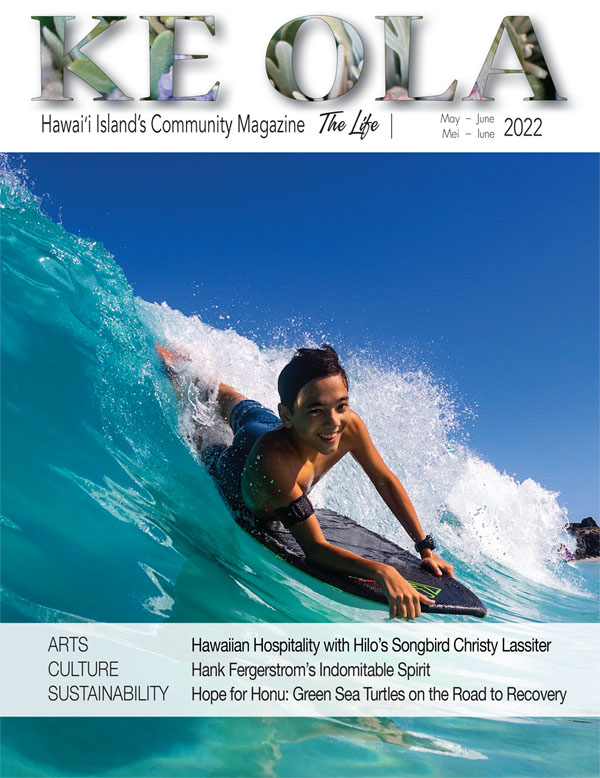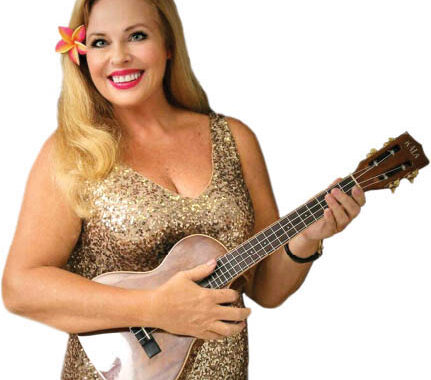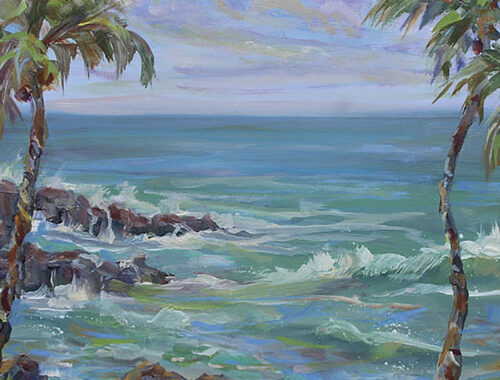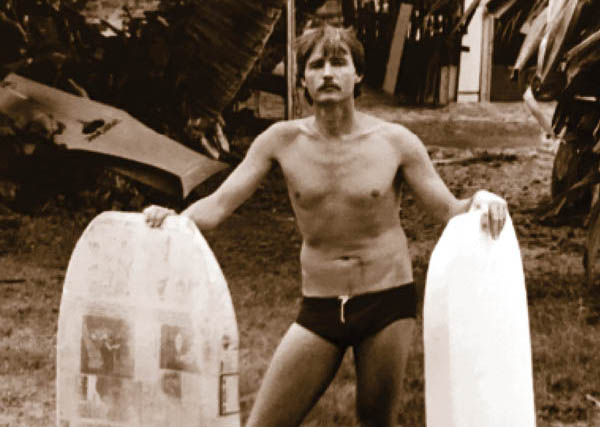
Birthplace of the Boogie Board: Wai‘aha Beach, Kona
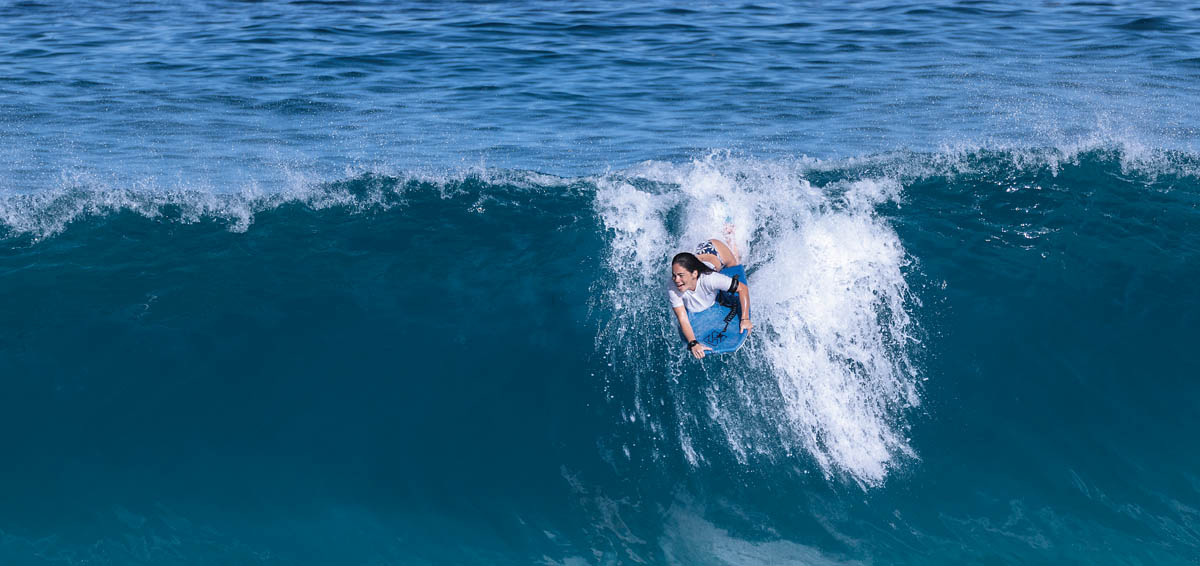
photo courtesy of Don Hurzeler
By Fern Gavelek
A small beach located just on the outskirts of Historic Kailua Village is officially the birthplace of the boogie board. Known by the local water sports community for decades, the designation was recently declared by state and county proclamation. Popularly called Honl’s, for the family that once lived there, its actual name is Wai‘aha Bay Beach Park. The unassuming spot is nestled just south of the Kona Reef condominiums on Ali‘i Drive, in Kailua Kona.
A new, two-sided historic marker shares the story of how the boogie board came to be on this unassuming strip of white sand beach. The flip side details how ancient Hawaiians rode waves on their bellies using a wooden paipo board. The marker was unveiled on November 6, 2021, also known as International Bodyboarding Day, during the 50th anniversary year of the invention of the boogie board.
Sponsored by Hawai‘i County Councilwoman Rebecca Villegas, the event included a paddle-out in honor of boogie board/bodyboard inventor Tom Morey, who passed away three weeks prior, at age 86. Bodyboard champion Mike Stewart led the traditional waterman’s memorial ceremony at the county park. Kumu Keala Ching did a chant acknowledging the connection of Wai‘aha to the past, present, and future.
“It was a gathering of about 150 bodyboarders extending through generations,” recalls Rep. Villegas, who grew up an avid bodyboarder. “Mike Stewart also organized simultaneous paddle-outs at different sites around the world.”
One of the paddle-out participants was Kailua-Kona’s Rex Honl, along with his grandchildren. He was 11 years old the day Tom Morey invented the boogie board on the beach bearing his family’s name and remembers it well.
The Invention of the Boogie Board
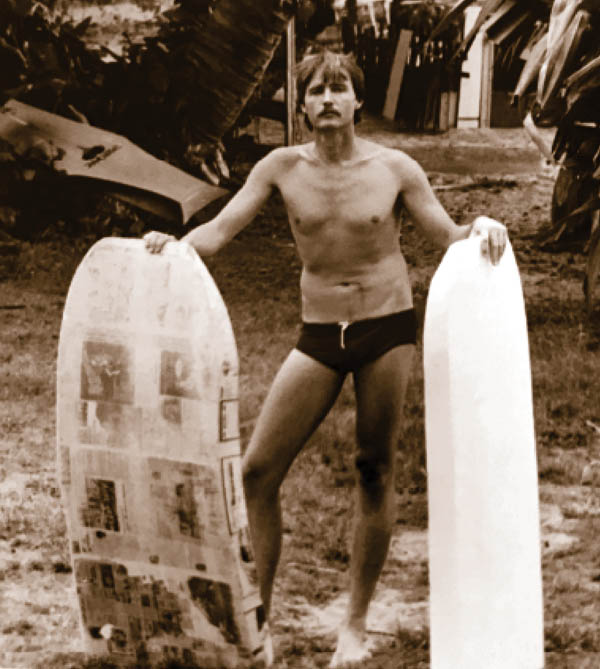
It was July 7, 1971 when Tom Morey, a surfer and engineer, fashioned the first-ever boogie board while living in a house that once stood on Honl’s Beach. In his garage, he took a nine-foot piece of polyethylene foam and cut it in half using his wife Marchia’s electric carving knife. The result was a torso-sized plank. According to the historic marker, he then “outlined a short board with a square tail, no fins, and squared-off nose that could be gripped for easier control and handling while riding waves in the prone position. To finish shaping his prototype, Tom laid down a copy of The Honolulu Advertiser on the foam and applied a hot clothes iron to smooth it and make the board somewhat watertight.”
Tom tried out his new board that day at Wai‘aha. He found he could feel the wave under his body, saying, “I thought this is nice, this is special—and maybe it could be something important.” The historic marker reads Tom “deliberately chose the name ‘boogie’ to describe his board, based on his love of jazz music.”
After Tom took out his invention, he invited Rex to give it a try.
“I rode it right over the shallow areas,” Rex remembers. “It was lightweight, fun, and felt really good. Little did we know Tom’s invention would change the life of so many.” Rex adds, “you can be a little kid or a grandparent” and ride waves with a boogie board. “Tom built it for fun, so all could enjoy the waves, even the average, everyday person.”
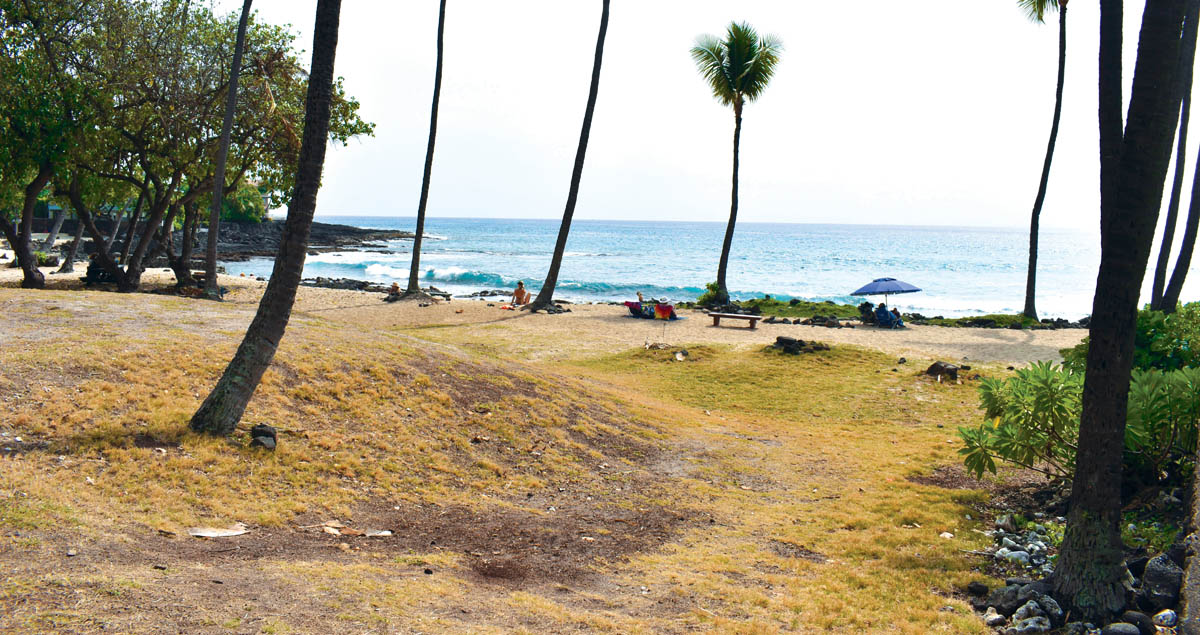
Boogie Board Creates Sport for All Ages
After moving to Carlsbad, California, Tom developed how-to kits so people could assemble their boogie board at home. According to the California Surf Museum website, the $25 kit included the handwritten and illustrated booklet “How to Skin Your Boogie” and two pieces of foam that had to be glued together to form the board’s “skins.” Tom persuaded Surfer magazine to place an ad on credit and the orders flooded in.
“Tom thought people would enjoy assembling their own board—kind of like an organic experience,” explains surf museum docent and former Kona resident Tom Dahnke. “Little did he know people would start coming back and asking Tom to assemble their boards…there were many misshaped ones.”
In 1975, Tom started manufacturing completed boards and his first big production was the hand-shaped 132BE. Toy company Kransco purchased the Morey Boogie in 1979 and soon it was in stores nationwide. It was bought by Mattel and then Wham-O, and by the 1980s, bodyboarding was a worldwide sensation. Today, there are numerous manufacturers of bodyboards, but they are still commonly referred to by Tom’s moniker, “boogie boards,” a word Merriam Webster defines as “a poor man’s surfboard, used for body surfing.”
Finding a Way to Commemorate the Story
Before the birth of the boogie board, Washington, DC native Mike Denney grew up bodyboarding on inflatable canvas surf mats in Ocean City, Maryland. As an adult he continued his love of wave riding on boogies in Portland, Maine. It was during a 2019 Hawai‘i Island vacation that Mike learned the beach across from his condo was the birthplace of the boogie board—and he thought it odd there wasn’t signage saying so.
“I think that fact is important to surf history and to Kona,” emphasizes Mike. “I felt the story needed to be told.”
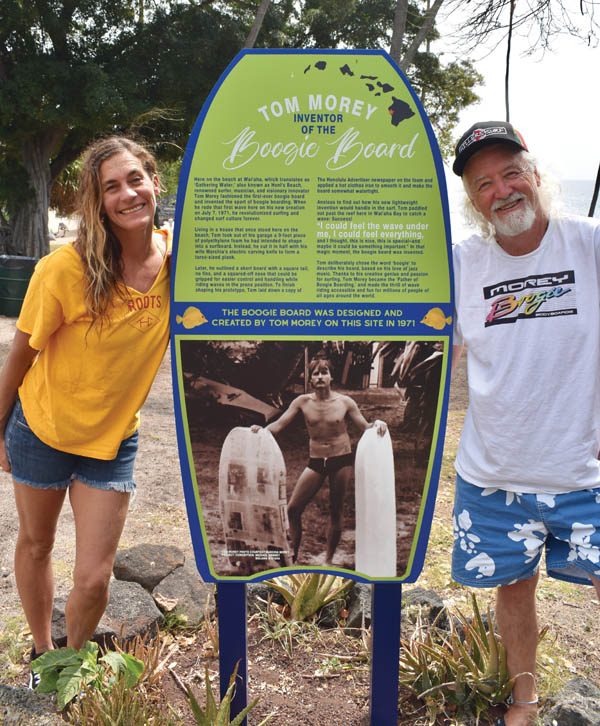
Mike reached out to Krista Donaldson, who in 2004 collaborated with a handful of Wai‘aha’s passionate, lifelong bodyboarders to create a contest to educate about Wai‘aha and perpetuate the sport of bodyboarding. Krista and Mike met in December 2020 and agreed on the need for a two-sided marker—one side would share about the boogie board while the other covered the Hawaiian paipo board. Krista also pledged the help of Malama Wai‘aha volunteers to help install the sign once it was ready.
Mike researched the history of the boogie board and was able to interview Tom Morey several times thanks to a contact at the Surfing Heritage and Culture Center in San Clemente, California. With Tom’s blessing and approval, Mike prepared the copy detailing the birth of the boogie board at Wai‘aha Beach and Tom’s wife furnished a photo of Tom with his first prototype board.
To provide narrative on the ancient Hawaiian paipo board, Mike relied on information found in Krista’s book, Malama Wai‘aha. He also talked to John NK Clark, leading Hawai‘i surf historian, and Marques Marzan, cultural advisor at Bishop Museum, to get a photo of a paipo board, reportedly dating from the 1600s and discovered in 1905 in the Ho‘okena burial cave of High Chiefess Kaneamuna.
Armed with the written and visual materials needed for the marker, Mike visited Ross Wilson at Current Events, a Kona public relations firm that’s been involved with creating historical signage around the island, including those seen throughout Historic Kailua Village.
“Mike came in with the idea and I said we could help because we need to tell the stories of the places here in our Kona District,” explains Ross. “Helping was the right thing to do and we’re thankful Mike Denney is around reminding us to do these things.”
Current Events donated the services to design the sign and help Mike procure a manufacturer. Abel Aquino of Kona did the design work and came up with the idea for the marker to be shaped like a boogie board. Mike paid to have the sign manufactured. Malama Wai‘aha volunteers installed the marker on the northeast end of the beach; it’s simply circled by a row of rocks and small plants. To those approaching from the street, the sign reads, “The Boogie Board was Designed and Created by Tom Morey on This Site in 1971.”
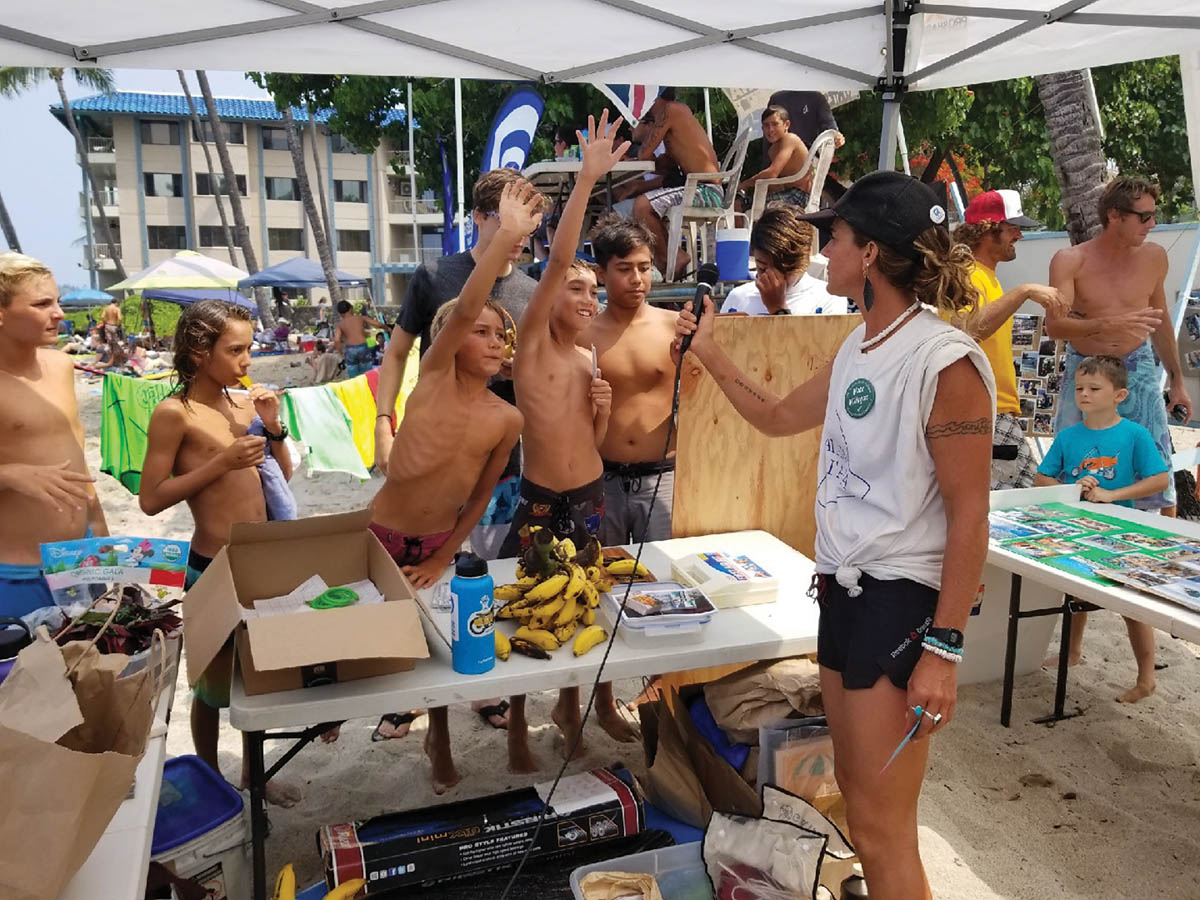
Perpetuating Wai‘aha’s Boogie Board Legacy
Krista Donaldson—a Kona charter school garden teacher, surf enthusiast, author, and self-described history buff—helped create the keiki surf contest at Wai‘aha after getting to know some of the beach’s hardest charging bodyboarders.
“Wai‘aha is the perfect place for bodyboarding and I thought we could have a contest while getting kids engaged with the history and culture of the place,” she recalls. “Kids had to clean up the beach for their entry fee.”
Billed as “Kona’s only and oldest bodyboarding contest at the birth beach of our sport—Wai‘aha,” the Roots Bodyboarding Contest is held annually in June. Besides competing on the waves, keiki (children) vie in fun games like the Bodyboard Limbo. They also win prizes for correctly answering questions like: What is an ahupua‘a? (land parcel from mountain to ocean). Or, what does Wai‘aha mean? (gathering water). Locally grown food is enjoyed by participants and the beach gets spruced up by the keiki.
Overseeing the contest are Malama Wai‘aha volunteers, who pitch in for beach cleanups, usually the first Sunday of each month. Through a County Friends of the Park agreement and an approved native planting plan, Krista and volunteers have also re-introduced native shoreline plants and colorful, hand-painted signs around the park. Plants are identified by their Hawaiian names as Krista “feels strongly we should reference people, things, and places by their Hawaiian names.”
Plans are in the works for the 2022 Roots Bodyboarding Contest in early June. Details for the 18th annual contest are available at Miller’s Surf in Kona, and event posters will be up on the beach. ❖
For more information: kristajoan@gmail.com
